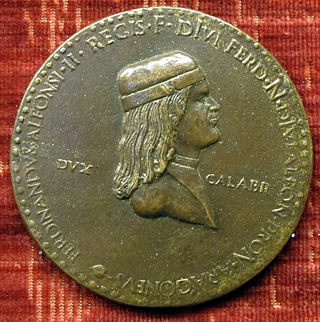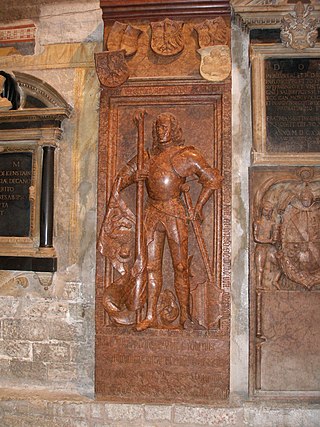
Francesco I Sforza was an Italian condottiero who founded the Sforza dynasty in the duchy of Milan, ruling as its (fourth) duke from 1450 until his death.

Ferdinand I, also known as Ferrante, was king of Naples from 1458 to 1494.

Ferdinand II was King of Naples from 1495 to 1496. He was the son of Alfonso II of Naples and the grandson of Ferrante I of Naples.

Charles of Durazzo, also called Charles the Small, was King of Naples and the titular King of Jerusalem from 1382 to 1386 as Charles III, and King of Hungary from 1385 to 1386 as Charles II. In 1381, Charles created the chivalric Order of the Ship. In 1383, he succeeded to the Principality of Achaea on the death of James of Baux.

The Kingdom of Naples was a state that ruled the part of the Italian Peninsula south of the Papal States between 1282 and 1816. It was established by the War of the Sicilian Vespers (1282–1302), when the island of Sicily revolted and was conquered by the Crown of Aragon, becoming a separate kingdom also called the Kingdom of Sicily. This left the Neapolitan mainland under the possession of Charles of Anjou. Later, two competing lines of the Angevin family competed for the Kingdom of Naples in the late 14th century, which resulted in the murder of Joanna I at the hands of her successor, Charles III of Naples. Charles' daughter Joanna II adopted King Alfonso V of Aragon as heir, who would then unite Naples into his Aragonese dominions in 1442.

The Duchy of Milan was a state in Northern Italy, created in 1395 by Gian Galeazzo Visconti, then the lord of Milan, and a member of the important Visconti family, which had been ruling the city since 1277. At that time, it included twenty-six towns and the wide rural area of the middle Padan Plain east of the hills of Montferrat. During much of its existence, it was wedged between Savoy to the west, Republic of Venice to the east, the Swiss Confederacy to the north, and separated from the Mediterranean by Republic of Genoa to the south. The duchy was at its largest at the beginning of the 15th century, at which time it included almost all of what is now Lombardy and parts of what are now Piedmont, Veneto, Tuscany, and Emilia-Romagna.

The Duchy of Parma and Piacenza was an Italian state created in 1545 and located in northern Italy, in the current region of Emilia-Romagna.

Frederick, sometimes called Frederick IV or Frederick of Aragon, was the last king of Naples from the Neapolitan branch of the House of Trastámara, ruling from 1496 to 1501. He was the second son of Ferdinand I, younger brother of Alfonso II, and uncle of Ferdinand II, his predecessor.

Pedro Álvarez de Toledo y Zúñiga was a Spanish politician. The first effective Spanish viceroy of Naples, in 1532–1552, he was responsible for considerable social, economic and urban improval in the city and southern Italian kingdom in general. He was the father-in-law of Cosimo I de' Medici, Grand Duke of Tuscany.

The Duchy of Naples began as a Byzantine province that was constituted in the seventh century, in the reduced coastal lands that the Lombards had not conquered during their invasion of Italy in the sixth century. It was governed by a military commander (dux), and rapidly became a de facto independent state, lasting more than five centuries during the Early and High Middle Ages. Naples remains a significant metropolitan city in present-day Italy.
The dukes of Naples were the military commanders of the ducatus Neapolitanus, a Byzantine outpost in Italy, one of the few remaining after the conquest of the Lombards. In 661, Emperor Constans II, highly interested in south Italian affairs, appointed a Neapolitan named Basil dux or magister militum. Thereafter a line of dukes, often largely independent and dynastic from the mid-ninth century, ruled until the coming of the Normans, a new menace they could not weather. The thirty-ninth and last duke, Sergius VII, surrendered his city to King Roger II of Sicily in 1137.

The Duchy of Sora was a semi-independent state in Italy, created in 1443 by King Alfonso I of Naples and dissolved in 1796. It occupied the south-eastern part of what is today Lazio, bordering what is now Abruzzo. Its capital was first Sora, and later, under the Boncompagni family, Isola di Sora.

The Principality of Salerno was a medieval Southern Italian state, formed in 851 out of the Principality of Benevento after a decade-long civil war. It was centred on the port city of Salerno. Although it owed allegiance at its foundation to the Carolingian emperor, it was de facto independent throughout its history and alternated its allegiance between the Carolingians and their successors in the West and the Byzantine emperors in the east.

Castel Nuovo, often called Maschio Angioino, is a medieval castle located in front of Piazza Municipio and the city hall in central Naples, Campania, Italy. Its scenic location and imposing size makes the castle, first erected in 1279, one of the main architectural landmarks of the city. It was a royal seat for kings of Naples, Aragon and Spain until 1815.
Theoctistus was the Duke of Naples during an ill-recorded period in its history. His reign began sometime around 818 and lasted until 821.

Duke or Duchess San Donato was a noble title, first created in 1602 by the Spanish King Philip III for the House of Sanseverino. The duchy was traditionally based on estates and territories held in San Donato di Ninea, Calabria. The first creation, however, lasted only 52 years. In 1668, the title was recreated for a wealthy merchant, Antonio Amitrano, who had some years earlier bought the feudal rights over the former dukes' territories. Descendants of the Ametrano family held the duchy, as one several titles, until it became extinct in the 1970s. There have been successive claims over the centuries by distant kinsmen of the first holders to claim the duchy; these remain unverified.

Gabriele Sforza, was a member of the Augustinian Order who served as Archbishop of Milan from 1445 to his death in 1457.

Roberto Sanseverino d'Aragona was an Italian condottiero, count of Colorno from 1458 to 1477 and count of Caiazzo from 1460 until his death in 1487. A highly esteemed man of arms, and a veteran of numerous battles, he was one of the greatest leaders of the Italian Renaissance.
Pandulf III was briefly the Prince of Salerno from around 3 to 10 June 1052. He was the eldest of four brothers of Gemma, wife of Prince Guaimar IV. He seized the throne in a coup d'état, when he and his brother assassinated Guaimar. He reigned for only a week before he was forced to step down and was promptly murdered.

The Duchy of Bari was a significant administrative division within the Kingdom of Naples, comprising several territories, including Acquaviva delle Fonti, Bari, Modugno, Ostuni, Palo del Colle, and Rossano. Bari, as the capital, functioned as a key administrative and economic center in the region, influencing trade and political activities. The included territories each contributed distinct characteristics to the duchy; for instance, Acquaviva delle Fonti is recognized for its agricultural output, while Ostuni is noted for its historical architecture.















